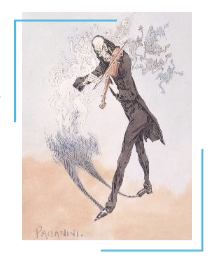Composed 1819; 8 minutes
 Paganini, the charismatic violinist who revolutionized violin technique, was the first touring virtuoso to electrify audiences across Europe. A rumor that he was in league with the devil only heightened his mystique—and he never denied it. He met Rossini early in his career, and they remained lifelong friends. Paganini chose three Rossini arias—from Tancredi, Mosè in Egitto, and La Cenerentola—as the basis for orchestral variation sets that are now ranked among his
Paganini, the charismatic violinist who revolutionized violin technique, was the first touring virtuoso to electrify audiences across Europe. A rumor that he was in league with the devil only heightened his mystique—and he never denied it. He met Rossini early in his career, and they remained lifelong friends. Paganini chose three Rossini arias—from Tancredi, Mosè in Egitto, and La Cenerentola—as the basis for orchestral variation sets that are now ranked among his
finest. Like much of his work, he kept these scores to himself and never published them.
His Introduction and Variations on the Prayer of Moses (Dal tuo stellato soglio) from Mosè in Egitto only appeared in print 15 years after his death. It likely dates from around 1819, the year before he challenged the violin world by publishing his Caprices, Op. 1. The Mosè–Fantasia opens with a noble, mournful melody in a minor key, later returning in the major. A brief cadenza introduces a march-like version of the theme, followed by three variations of mounting virtuosity and a rapid-fire finale. Sigismond Thalberg wrote dazzling piano variations on the same aria. Cellist Paul Tortelier, like Paganini before him, famously performed at least part of the Variations on a single string. The Galvin Quartet spares no expense and incorporates all 16 strings of their four cellos.